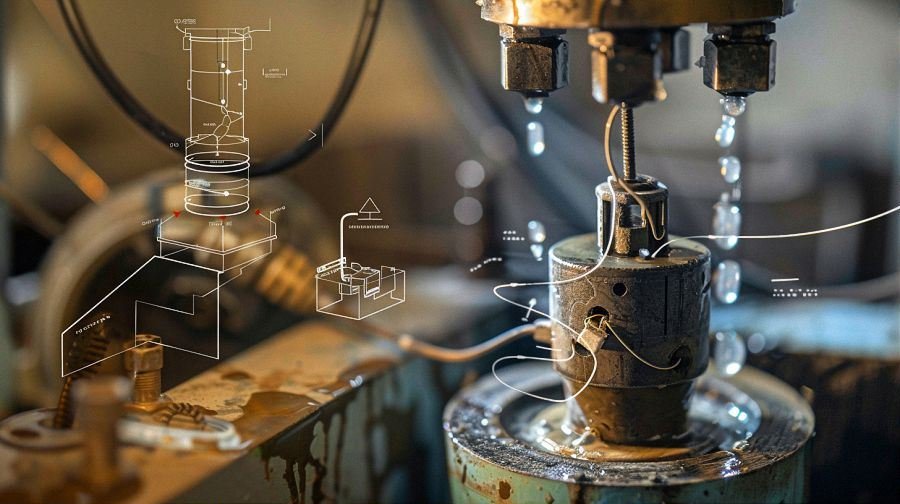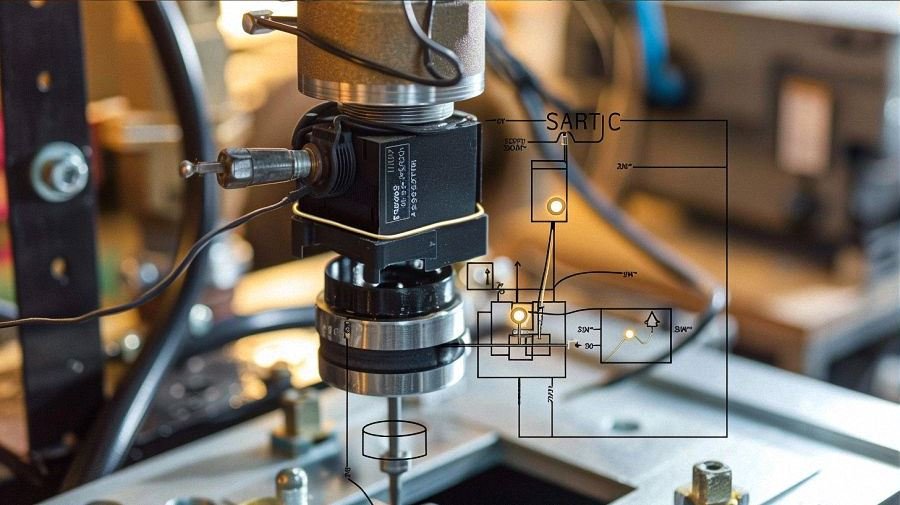Optimize Deep-Well Pump: Capacitor Connection Guide

Understanding Drainage Pumps with Floats
Contents
ToggleOverview of Drainage Pump Mechanism
When it comes to efficiently managing water levels in residential or commercial spaces, drainage pumps with floats play a pivotal role. These pumps are designed to remove excess water from basements, crawl spaces, and other areas prone to flooding or water accumulation. At the heart of their operation lies a mechanism that integrates a float system, ensuring automatic activation and deactivation based on water levels.
The starting capacitor connecting a deep-well pump through a capacitor is a critical component of these pumps, facilitating their smooth operation. Essentially, when water reaches a certain level, the float switch triggers the pump to activate, drawing water into the pump chamber. As the water level decreases, the float switch disengages, halting the pump operation until water levels rise again.
Explanation of how drainage pumps function, including the role of floats.
Drainage pumps utilize a combination of mechanical and electrical components to effectively remove water from enclosed spaces. The starting capacitor connecting a deep-well pump through a capacitor is integral to kick-starting the pump’s motor, providing the necessary torque for efficient water extraction.
Once activated, the pump’s impeller creates a suction force, pulling water into the pump chamber. As water accumulates, the float switch—typically positioned within the pump housing—monitors the water level. When the water level surpasses a predetermined threshold, the float switch triggers the pump motor to start, initiating the pumping process.
As the pump evacuates water, the float switch continues to monitor the water level. When the water level drops below a certain point, the float switch disengages, signaling the pump to cease operation until water levels rise again. This cyclic process ensures optimal water management without the need for constant manual intervention.
Comparing Drainage Pumps with Different Float Systems
The effectiveness of a drainage pump heavily relies on the efficiency of its float system. Various float mechanisms exist, each offering distinct advantages and limitations that impact pump performance.
1. Vertical Float Switches:
- Positioned vertically within the pump housing.
- Activated when water levels rise, triggering the pump to start.
- Ideal for narrow pump chambers or areas with limited space.
2. Tethered Float Switches:
- Attached to the pump via a flexible tether.
- Move freely within the pump chamber, adjusting to changing water levels.
- Suitable for applications with varying water depths, providing flexibility in activation.
3. Electronic Float Switches:
- Utilize sensors to detect water levels electronically.
- Offer precise control over pump activation, minimizing the risk of false starts or stops.
- Commonly used in modern drainage pump systems for enhanced reliability and accuracy.
Factors Influencing Float Pump Adjustment
Achieving optimal pump performance requires careful calibration and adjustment of float switches to suit specific application requirements. Several factors influence the adjustment of float pumps, ensuring seamless operation and preventing issues such as pump cycling or inadequate water removal.
1. Water Level Variability:
- Consider the typical range of water levels in the application area.
- Adjust float switches to activate and deactivate the pump within this range, optimizing water removal efficiency.
2. Pump Cycle Time:
- Determine the desired frequency of pump activation based on water ingress rates.
- Fine-tune float switch settings to minimize pump cycling without compromising on water management capabilities.
3. Environmental Conditions:
- Account for factors such as temperature fluctuations and debris accumulation.
- Regularly inspect and adjust float switches to ensure reliable operation in diverse environmental conditions.
By understanding these key aspects of drainage pumps with floats, users can maximize their effectiveness in managing water levels and safeguarding properties against potential water damage. Whether in residential basements, commercial facilities, or agricultural settings, the proper configuration and adjustment of float pumps are essential for maintaining optimal water drainage performance.

Installation Guide for Submersible Drainage Pumps
Pre-Installation Preparations
Before diving into the installation process of your submersible drainage pump, it’s crucial to ensure that the well or drainage area is adequately prepared. Follow these steps to set the stage for a successful installation:
-
Clear Debris and Obstructions:
- Begin by clearing the well or drainage area of any debris, rocks, or other obstructions that may impede the installation process.
- Inspect the area for potential hazards or obstacles that could interfere with pump operation once installed.
-
Check Water Quality:
- Assess the quality of the water in the well or drainage area to identify any contaminants or sediment that may affect pump performance.
- Consider installing a filtration system if the water quality is poor to prevent damage to the pump over time.
-
Evaluate Electrical Connections:
- Ensure that the electrical connections near the installation site are in good condition and capable of supporting the pump’s power requirements.
- Verify that there is a reliable power source nearby to connect the pump once installed.
-
Measure Water Depth:
- Determine the depth of the water source to select an appropriate submersible pump with the necessary reach to effectively pump water from the desired depth.
- Take accurate measurements to ensure the pump is positioned at the optimal depth for efficient operation.
Step-by-Step Installation Process
Now that you’ve completed the pre-installation preparations, it’s time to proceed with the installation of your submersible drainage pump. Follow these step-by-step instructions for a seamless installation experience:
-
Position the Pump:
- Lower the submersible pump into the well or drainage area, ensuring it is securely positioned at the desired depth.
- Use a rope or cable to guide the pump into place and prevent it from drifting during installation.
-
Connect the Float Switch:
- Attach the float switch to the pump according to the manufacturer’s instructions, ensuring proper alignment for accurate water level detection.
- Securely fasten the float switch to prevent it from becoming dislodged during operation.
-
Secure Electrical Connections:
- Connect the pump’s electrical wiring to the power source, following all safety guidelines and local regulations.
- Double-check the connections to ensure they are tight and secure to prevent electrical hazards.
-
Test Pump Operation:
- Activate the pump to test its functionality and ensure that water is being pumped effectively from the well or drainage area.
- Monitor the pump’s performance closely during the initial testing phase to identify any issues or irregularities.
Ensuring Proper Functionality
After completing the installation process, it’s essential to verify that your submersible drainage pump is functioning correctly and efficiently. Follow these tips to ensure proper functionality:
-
Monitor Water Levels:
- Regularly check the water levels in the well or drainage area to ensure the pump is effectively removing excess water.
- Adjust the float switch settings as needed to maintain optimal water levels and prevent flooding or over-pumping.
-
Perform Routine Maintenance:
- Schedule regular inspections and maintenance checks to keep your submersible pump in top condition.
- Clean the pump and filter regularly to remove debris and sediment that could impair performance.
-
Address Any Issues Promptly:
- If you encounter any issues or abnormalities with your pump’s operation, address them promptly to prevent further damage or malfunction.
- Consult the manufacturer’s guidelines or seek professional assistance if necessary to resolve any technical issues.
By following these installation guidelines and maintenance tips, you can ensure that your submersible drainage pump operates efficiently and effectively, providing reliable water management solutions for your property.

Optimizing Deep-Well Pump Performance with Capacitors
Understanding Capacitor Integration
Capacitors play a crucial role in enhancing the performance of deep-well pumps, but how exactly do they achieve this? Let’s delve into the mechanics behind capacitor integration and its impact on pump functionality.
Capacitors act as energy storage devices, providing an additional boost of power to start the motor of a deep-well pump. In essence, they serve as a reservoir of electrical energy, supplying the necessary voltage and current to kick-start the pump’s motor when it initially engages.
By harnessing the power of capacitors, deep-well pumps can overcome the high starting torque required to lift water from deep underground reservoirs. This ensures swift and efficient pump activation, minimizing delays and optimizing overall pump performance.
Connecting Deep-Well Pumps via Capacitors
Now that we understand the significance of capacitors in deep-well pump operation, let’s explore the intricate process of connecting these pumps via capacitors. Follow these detailed guidelines to ensure a seamless wiring and connection process:
-
Identify Capacitor Placement:
- Determine the optimal location for mounting the capacitor within the pump’s electrical system.
- Position the capacitor in a secure and accessible location, away from sources of heat or moisture that could compromise its performance.
-
Select the Correct Capacitor:
- Choose a capacitor with the appropriate voltage and capacitance ratings to match the specifications of your deep-well pump.
- Refer to the pump manufacturer’s guidelines or consult with a professional to ensure compatibility and optimal performance.
-
Wiring Configuration:
- Connect the capacitor in parallel with the pump motor to ensure smooth operation and efficient power delivery.
- Follow the wiring diagram provided by the pump manufacturer, paying close attention to polarity and terminal connections.
-
Secure Connections:
- Use high-quality electrical connectors and insulation materials to secure the capacitor connections and prevent electrical hazards.
- Double-check all connections to ensure they are tight and properly insulated to withstand the rigors of pump operation.
Benefits and Considerations
As with any technological enhancement, integrating capacitors into deep-well pumps offers a range of benefits along with some considerations to keep in mind:
Benefits:
- Improved Starting Torque: Capacitors provide the extra power needed to overcome initial inertia and start the pump motor smoothly.
- Energy Efficiency: By optimizing motor startup, capacitors help reduce energy consumption and minimize strain on the electrical system.
- Enhanced Reliability: With capacitors in place, deep-well pumps experience fewer instances of motor stalling or failure, leading to increased operational reliability.
Considerations:
- Compatibility Issues: Not all deep-well pumps are designed to accommodate capacitor integration, so compatibility must be verified before installation.
- Maintenance Requirements: Capacitors may require periodic inspection and replacement to ensure continued functionality and prevent system failures.
- Electrical Safety: Improper installation or handling of capacitors can pose electrical hazards, so it’s essential to adhere to safety guidelines and best practices.
By weighing the benefits against the considerations and following proper installation procedures, you can effectively optimize deep-well pump performance with capacitors, ensuring reliable water supply for your residential or commercial needs.

